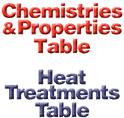
(AISI 420 modified with high vanadium)
The wear and corrosion resistance of CPM S90V make it an excellent candidate to replace 440C, where increased wear is a primary concern. It can replace D2 or other tool steels in applications where improved corrosion resistance is also of benefit.
| Typical Chemistry | |
| Carbon | 2.30% |
| Chromium | 14.00% |
| Vanadium | 9.00% |
| Molybdenum | 1.00% |
| Typical Applications | |
| Plastic Injection and Extrusion Feedscrews | |
| Non-return Valve Components | |
| Pelletizing Equipment | |
| Gate and Nozzle Inserts | |
| Industrial Knives, Slitters, and Cutters | |
| Long-wearing Specialty Cutlery | |
| Injection Molds and Inserts | |
| Wear Components for Food and Chemical Processing | |
| Bearings, Bushings, Valves, Rolls | |
| Gear Pumps | |
- Machinability and Grindability
Due to its high vanadium carbide content, the machinability and grindability of S90V will be slightly more difficult than that of D2 or 440C. Similar grinding equipment and practices are acceptable. SG type alumina wheels or CBN wheels have generally given the best performance with the CPM steels.
Thermal Treatments
Annealing: 1650°F (900°C), hold 2 hours, slow cool no faster than 25°F (15°C) per hour to 1000°F (540°C), then furnace cool or cool in still air to room temperature.
Annealed Hardness: Approx. BHN 277.
Stress Relieving:
Annealed Parts: Heat to 1100-1300°F (595-705°C), hold 2 hours, then furnace cool or cool in still air.
Hardened Parts: Heat to 25-50°F (15-30°C) below original tempering temperature, hold 2 hours, then furnace cool or cool in still air.
Hardening:
Austenitize: 2100-2150°F (1150-1175°C) Hold time at temperature: 10-30 minutes
Quench: Salt quench, interrupted oil quench, positive pressure gas quench or air cool at a minimum cooling rate of 150°F/min (80°C)/min) to below 1000°C (540°C) followed by still air or moderately forced air cooling to below 125°F (50°C). For optimum vacuum heat treatment response, a minimum 4 bar gas quench is recommended.
Temper: For an optimum combination of hardness, wear resistance and corrosion resistance, double temper at 400-750°F (200-400°C). Hold for a minimum of 2 hours each temper. For optimum stress relieving and dimensional stability, S90V may be double tempered at 1000-1025°F (540-550°C), but tempering above 800°F (425°C) may result in some loss of corrosion resistance. A freezing treatment may be employed between the first and second tempers, if desired. Freezing treatments should always be followed by at least one temper.
PLEASE NOTE: Tempering between about 800 and 1000°F (425 and 540°C) is not recommended. All martensitic stainless steels suffer from embrittlement when tempered in this range.
Aim Hardness: HRC 56-59
Size Change: +0.03 to +0.05%
Size change shown is for a fully martensitic microstructure. The presence of retained austenite may reduce the net growth. When tempering at 400-750°F (200-400°C), freezing treatments may be necessary to minimize retained austenite.

|
|
||||
|
|
||||
|
|
ft-lbs |
|
|
|
|
||||
| CPM S90V | 58 | (A) | 19 | (26) |
| 440C | 58 | (B) | 16 | (22) |
| D2 | 59 | (C) | 22 | (30) |
|
|
||||
B=Hardened 1900°F (1040°C), double tempered 400°F (204°C)
C=Hardened 1850°F (1010°C), double tempered 600°F (315°C)
(2) Charpy C-notch impact test
|
|
||
| Corrosion Test Results (1) | ||
|
|
|
|
|
|
||
|
|
|
|
|
|
|
|
|
|
||
(2) # pits/in2, in solutions of 2% and 5% NaCI (salt water) at 95°F (35°C)
(3) mils/month, in 5% HNO3 -1% HCI (nitric+hydrochloric acids) room temperature
Because of its usual low tempering temperature, CPM S90V is not usually readily nitrided or TiN coated.
Physical Properties
Modulus of Elasticity .........................................................31 psi x 106 (215 GPa)
Specific Gravity ...................................................................................................7.40
Density .............................................................................0.270 lb/in3 (7400 kg/m3)
Thermal Conductivity (at room temperature)
................................ 9.7 BTU/hr/ft/°F (0.04 Cal/cm2/sec/°C)
Coefficient of Thermal Expansion
|
|
||
|
|
|
|
|
|
|
|
|
|
|
|
|
|
|